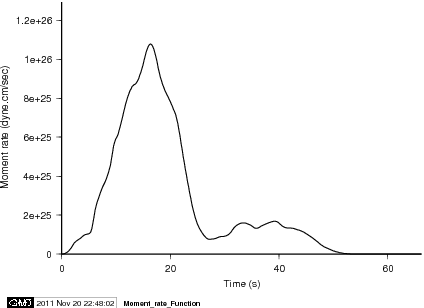Preliminary Result of the Mar 9, 2011 Mw 7.4 Sanriku-Oki Earthquake
Guangfu Shao, Chen Ji, UCSB
DATA Process and Inversion
We used the GSN broadband waveforms downloaded from the IRIS DMC. We analyzed 30 teleseismic broadband P waveforms, 21 broadband SH waveforms, 48 long period surface waves, three-component strong motion data at 23 KiK-net stations, and 42 horizontal GPS vectors selected based upon data quality and azimuthal distribution. Waveforms are first converted to displacement by removing the instrument response and then used to constrain the slip history based on a finite fault inverse algorithm (Ji et al, 2002). We use our relocated hypocenter (Lon.=143.1200 deg.; Lat.=38.3400 deg.; Depth=14km). The fault planes are defined using the quick moment tensor solution of the Global CMT.
Our study results of this earthquake has been published in a recent GRL paper (Shao et al, 2011). Please check the paper for further details.
Result
After comparing the waveform fits based on two planes, we find that the nodal plane (strike=190.00 deg., dip=11.00 deg.) fits the data better. The seismic moment release based upon this plane is
0.160E+28 dyne.cm using a 1D crustal model interpolated from CRUST2.0 (Bassin et al., 2000).
Cross-section of slip distribution

Figure 1.1 Cross-section of slip distribution. the strike direction of fault plane is indicated by the black arrow and the hypocenter location is denoted by the red star. The slip amplitude are showed in color and motion direction of the hanging wall relative to the footwall is indicated by white arrows. Contours show the rupture initiation time in seconds.
Moment rate function

Comparison of data and synthetic seismograms

Figure 2.1. Comparison of teleseismic body waves. Data are shown in black and synthetic seismograms are plotted in red. Both data and synthetic seismograms are aligned on the P or SH arrivals. The number at the end of each trace is the peak amplitude of the observation in micro-meter. The number above the beginning of each trace is the source azimuth and below is the epicentral distance.

Figure 2.2. Comparison of teleseismic body waves. Data are shown in black and synthetic seismograms are plotted in red. Both data and synthetic seismograms are aligned on the P or SH arrivals. The number at the end of each trace is the peak amplitude of the observation in micro-meter. The number above the beginning of each trace is the source azimuth and below is the epicentral distance.

Figure 3.1. Comparison of long period surface waves. Data are shown in black and synthetic seismograms are plotted in red. Both data and synthetic seismograms are aligned on the earthquake origin time. The number at the end of each trace is the peak amplitude of the observation in millimeter. The number above the beginning of each trace is the source azimuth and below is the epicentral distance in degrees.

Figure 3.2. Comparison of long period surface waves. Data are shown in black and synthetic seismograms are plotted in red. Both data and synthetic seismograms are aligned on the earthquake origin time. The number at the end of each trace is the peak amplitude of the observation in millimeter. The number above the beginning of each trace is the source azimuth and below is the epicentral distance in degrees.

Figure 4. Comparison of strong motion waves at 23 KiK-net stations. Data are shown in black and synthetic seismograms are plotted in red. Both data and synthetic seismograms are aligned P-wave arrivals. The number at the end of each trace is the peak amplitude of the observation in centimeters. The number above the beginning of each trace is the source azimuth in degrees and below is the epicentral distance in km.


Figure 5. Left: comparison of GPS horizontal components with data in black and synthetic displacements in red. Right: GPS residuals between the data and synthetics. The GPS vectors were preliminary GPS displacement data provided by the ARIA team at JPL and Caltech (Courtesy of Dr. Susan Owen).

Figure 6. Surface projection of the slip distribution superimposed on ETOPO2. The black line indicates the major plate boundary [Bird, 2003]. Red and open stars indicate the epicenters of this earthquake and the M9 Tohoku-Oki earthquake, respectively. Beachball indicates the GCMT solution.
CJ's Comments:
Not Available Yet
Slip Distribution
References
Shao, G., C. Ji, and D. Zhao, Rupture process of the 9 March, 2011 Mw 7.4 Sanriku-Oki, Japan earthquake constrained by jointly inverting teleseismic waveforms, strong motion data and GPS observations, Geophys. Res. Lett., 38, L00G20, 2011, doi:10.1029/2011GL049164.
Ji, C., D.J. Wald, and D.V. Helmberger, Source description of the 1999 Hector Mine, California earthquake; Part I: Wavelet domain inversion theory and resolution analysis, Bull. Seism. Soc. Am., Vol 92, No. 4. pp. 1192-1207, 2002.
Bassin, C., Laske, G. and Masters, G., The Current Limits of Resolution for Surface Wave Tomography in North America, EOS Trans AGU, 81, F897, 2000.
Acknowledgement and Contact Information
This work is supported by National Earthquake Information Center (NEIC) of United States Geological Survey. This web page is built and maintained by Dr. C. Ji at UCSB.









